Experimental Study of Deformation Measurement of Bored Pile Using OFDR and BOTDR Joint Optical Fiber Sensing Technology
Abstract
1. Introduction
2. Optical Fiber Sensing Principle
2.1. OFDR Sensing Technology Principle
2.2. BOTDR Sensing Technology Principle
3. Field Test
3.1. Project Overview
3.2. Original Test Results
3.3. Data Denoising and Smoothing
3.4. Comparison of Monitoring Results
3.5. OFDR–BOTDR Joint Sensing Method Engineering Application
4. Conclusions
- (1)
- OFDR technology and BOTDR technology can realize distributed monitoring of the deformation of bored cast-in-place pile foundation. Data monitored with the two technologies show the same change trend. OFDR has higher accuracy and less data volatility, enabling refined measurement and analysis;
- (2)
- The combined processing method of db wavelet function and adjacent-average method was used to denoise and smooth the monitoring data; the appropriate processing parameters were selected. BOTDR technology can achieve the certain sensing effect of the OFDR technology in strain sensing with this method, which makes up for the shortcoming of the low sensing accuracy of BOTDR technology;
- (3)
- For large-scale geotechnical engineering, BOTDR technology can be used to conduct distributed sensing to determine the deformation characteristics and force law; OFDR technology can be applied to achieve refined research of small-scale key engineering parts. OFDR and BOTDR joint optical fiber sensing technology can make up for the shortcomings of the lower accuracy of BOTDR and the limited sensing range of OFDR. It has broad prospects in large-scale project monitoring.
Author Contributions
Funding
Data Availability Statement
Conflicts of Interest
References
- Zhu, Y.; Zhu, H.H.; Zhang, W.; Shi, B. Parametric analysis of influencing factors of slope stability strengthened by anti-sliding pile. J. Eng. Geol. 2017, 25, 833–840. [Google Scholar]
- Shi, B.; Xu, H.Z.; Zhang, D.; Ding, Y.; Cui, H.L. Feasibility study on application of BOTDR strain monitoring technology in health diagnosis of large-scale foundation engineering. Chin. J. Rock Mech. Eng. 2004, 23, 493–499. [Google Scholar]
- Gao, L.; Chen, H.D.; Yu, X.J.; Zhou, B. Research progress of distributed optical fiber sensing technology in geotechnical and geological engineering. J. Hydraul. Waterw. Eng. 2013, 2, 93–99. [Google Scholar]
- Zhu, H.H.; Shi, B.; Zhang, C.C. FBG-based monitoring of geohazards: Current status and trends. Sensors 2017, 17, 452. [Google Scholar] [CrossRef]
- Ferraro, P.; De Natale, G. On the possible use of optical fiber Bragg gratings as strain sensors for geodynamical monitoring. Opt. Lasers Eng. 2002, 37, 115–130. [Google Scholar] [CrossRef]
- Cao, Y.; Sun, Y.J.; Hu, X.F.; Xu, H.Z.; Gao, L. Experimental study on distributed deformation detection model of foundation pile under horizontal load. Chin. J. Undergr. Space Eng. 2021, 17, 107–116. [Google Scholar]
- Bersan, S.; Bergamo, O.; Palmieri, L.; Schenato, L.; Simonini, P. Distributed strain measurements in a CFA pile using high spatial resolution fibre optic sensors. Eng. Struct. 2018, 160, 554–565. [Google Scholar] [CrossRef]
- Gao, L.; Gong, Y.H.; Liu, H.L.; Ji, B.Q.; Xuan, Y.N.; Ma, Y. Experiment and numerical study on deformation measurement of cast-in-place concrete large-diameter pipe pile using optical frequency domain reflectometer technology. Appl. Sci. 2018, 8, 1450. [Google Scholar] [CrossRef]
- Boujia, N.; Schmidt, F.; Chevalier, C.; Siegert, D.; van Bang, D.P. Distributed optical fiber-based approach for soil–structure interaction. Sensors 2020, 20, 321. [Google Scholar] [CrossRef]
- Seo, H. Monitoring of CFA pile test using three dimensional laser scanning and distributed fiber optic sensors. Opt. Lasers Eng. 2020, 130, 106089. [Google Scholar] [CrossRef]
- Xiao, H.L.; Liu, Y.L.; Huang, S.L.; Li, L.H.; Ma, Q. Influence of temperature on BOTDR used to monitor stabilizing piles. J. Test. Eval. 2021, 49, 1004–1019. [Google Scholar] [CrossRef]
- Miao, P.Y.; Wang, B.J.; Shi, B.; Zhang, Q.Q. Application of feature point compression algorithm in distributed fiber optic pile foundation inspection. Rock Soil Mech. 2017, 38, 911–917. [Google Scholar]
- Yue, J.P.; Xi, G.Y.; Li, N. Processing of monitoring data from distributed optical fiber temperature sensor based on multi-wavelet. J. Hohai Univ. Nat. Sci. 2008, 36, 675–678. [Google Scholar]
- Zhang, Z.L.; Gao, L.; Sun, Y.Y.; Zhang, Q.H.; Zeng, P. Study on strain transfer law of distributed fiber optic sensor. Chin. J. Lasers 2019, 46, 0410001. [Google Scholar] [CrossRef]
- Luo, M.M.; Liu, J.F.; Tang, C.J.; Wang, X.F.; Lan, T.; Kan, B.X. 0.5 mm spatial resolution distributed fiber temperature and strain sensor with position-deviation compensation based on OFDR. Opt. Express 2019, 27, 35823–35829. [Google Scholar] [CrossRef]
- Zhang, Z.P.; Fan, X.Y.; He, Z.Y. Long-range distributed static strain sensing with <100 nano-strain resolution realized using OFDR. J. Light. Technol. 2019, 37, 4590–4596. [Google Scholar]
- Weng, Y.; Ip, E.; Pan, Z.; Wang, T. Singlend simultaneous temperature and strain sensing techniques based on Brillouin opticaltime domain reflectometry in fewmode fibers. Opt. Express 2015, 23, 9024–9039. [Google Scholar] [CrossRef]
- Fabien, R.; Bao, X.; Li, Y.; Yu, Q.; Yale, A.; Kalosha, V.P.; Chen, L. Signal processing technique for distributed Brillouin sensing at centimeter spatial resolution. Light. Technol 2007, 25, 3610–3618. [Google Scholar]
- Zhang, D.; Xu, H.Z.; Shi, B.; Sui, H.B.; Wei, G.Q. Brillouin power spectrum analysis for partially uniformly strained optical fiber. Opt. Lasers Eng. 2009, 47, 976–981. [Google Scholar] [CrossRef]
- Kee, H.H.; Lees, G.P.; Newson, T.P. All-fiber system for simultaneous interrogation of distributed strain and temperature sensing by spontaneous Brillouin scattering. Opt. Lett. 2000, 25, 695–697. [Google Scholar] [CrossRef]
- Horiguchi, T.; Shimizu, K.; Kurashima, T.; Tateda, M.; Koyamada, Y. Development of a distributed sensing technique using Brillouin scattering. J. Light. Technol. 1995, 13, 1296–1302. [Google Scholar] [CrossRef]
- Sakairi, Y.; Uchiyama, H.; Li, Z.M.; Adachi, S. System for measuring temperature and strain separately by BOTDR and OTDR. Adv. Sens. Syst. Appl. 2002, 4920, 274–284. [Google Scholar]
- Hong, C.Y.; Zhang, Y.F.; Li, G.W.; Zhang, M.X.; Liu, Z.X. Recent progress of using Brillouin distributed fiber optic sensors for geotechnical health monitoring. Sens. Actuators A Phys. 2017, 258, 131–145. [Google Scholar] [CrossRef]
- Qiu, W.W.; Sui, Q.M.; Zhang, G.T.; Wei, B. Research on noise removal of BOTDR fiber temperature sensing system based on wavelet transform. Laser Optoelectron. Prog. 2004, 11, 26–29. [Google Scholar]
- Piao, C.D.; Shi, B.; Wei, G.Q.; Zhu, Y.Q.; Zhang, D. Application of distributed optical fiber sensing technology in borehole pile detection. Chin. J. Geotech. Eng. 2008, 30, 976–981. [Google Scholar]
- Gao, L.; Zhou, L.; Liu, H.L.; Huang, J.; Wang, Y. Field experimental study on high precision measurement of pile deformation of cast-in-place pile. Geotech. Mech. 2021, 42, 2004–2014. [Google Scholar]
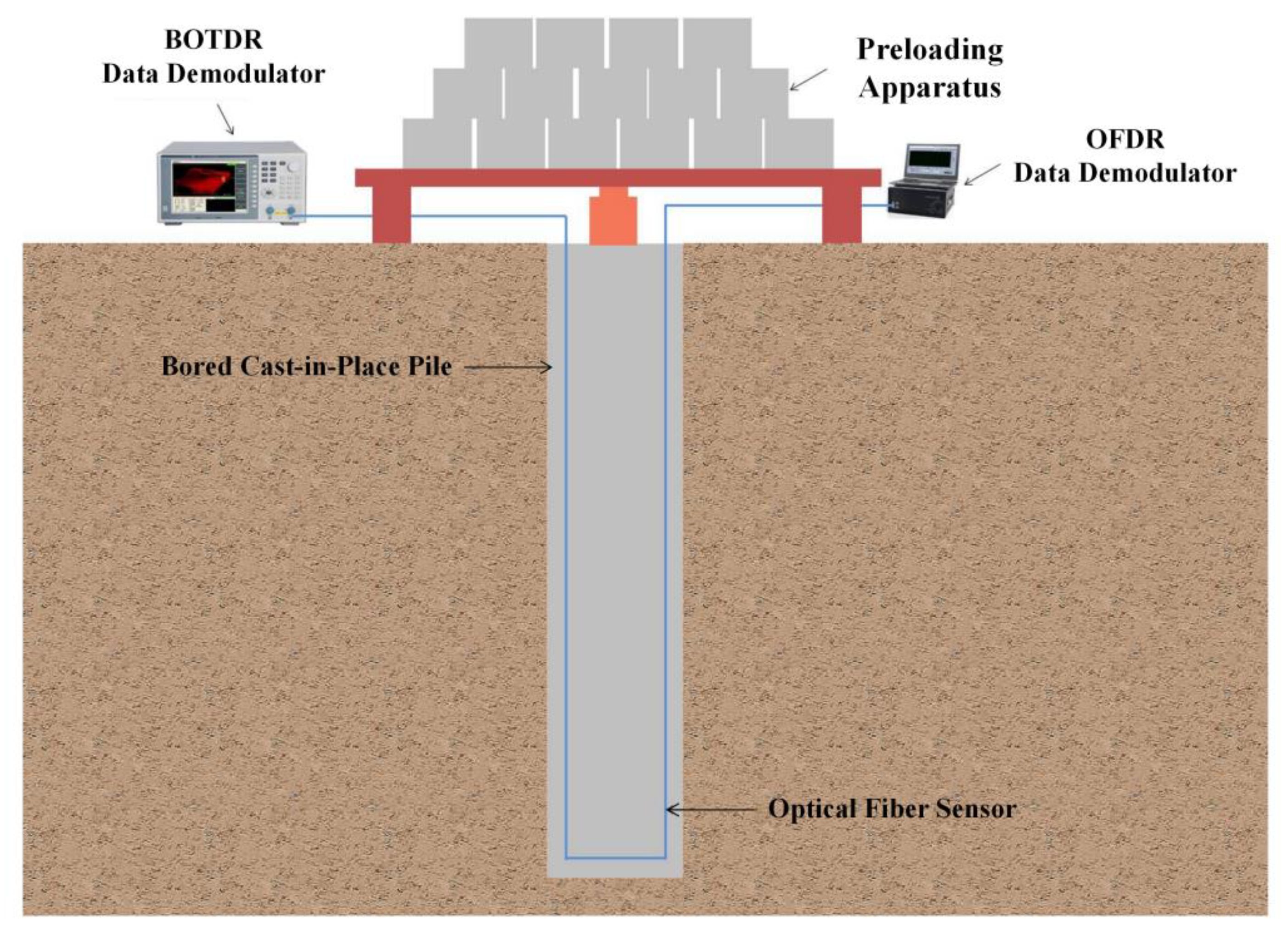

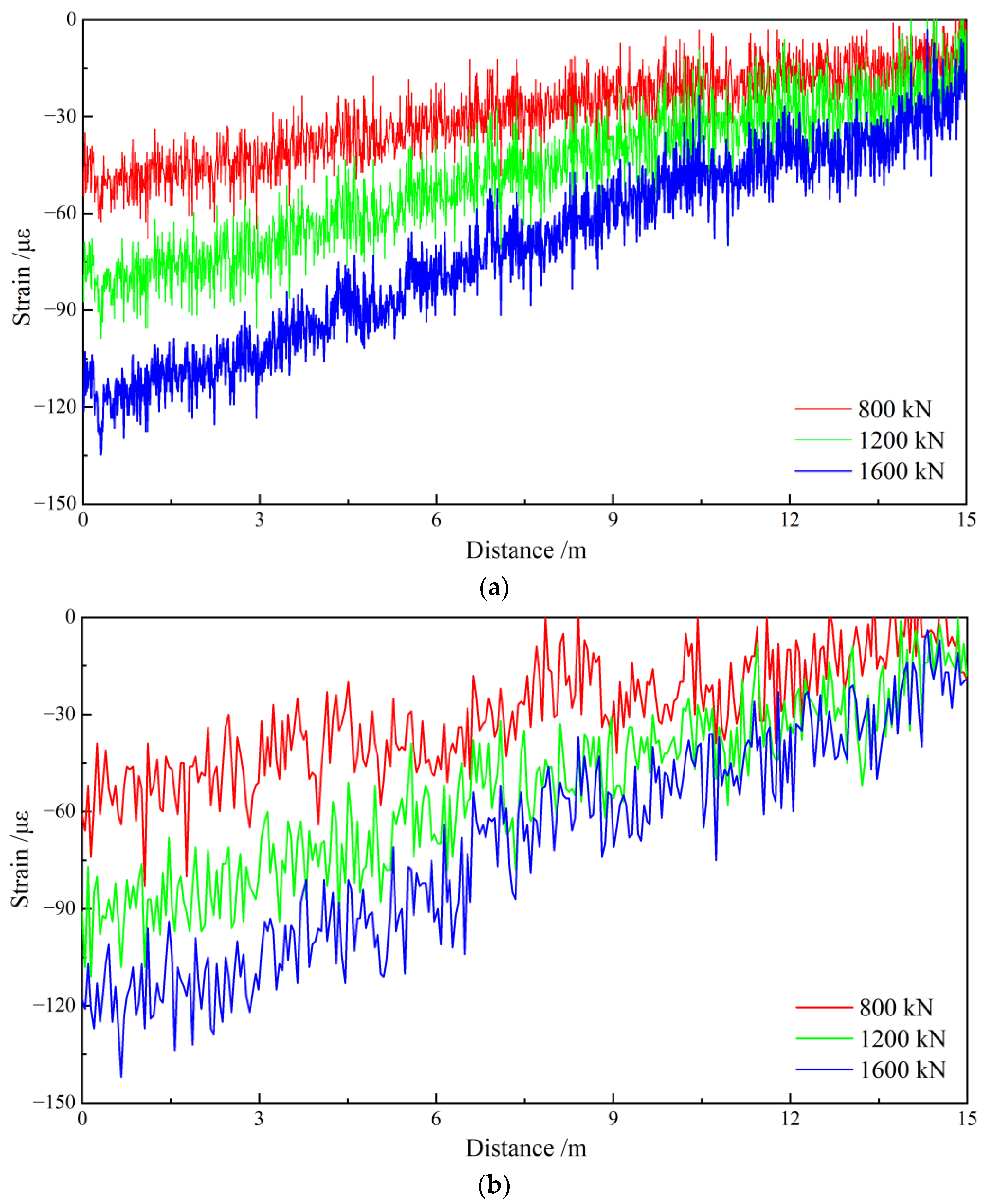
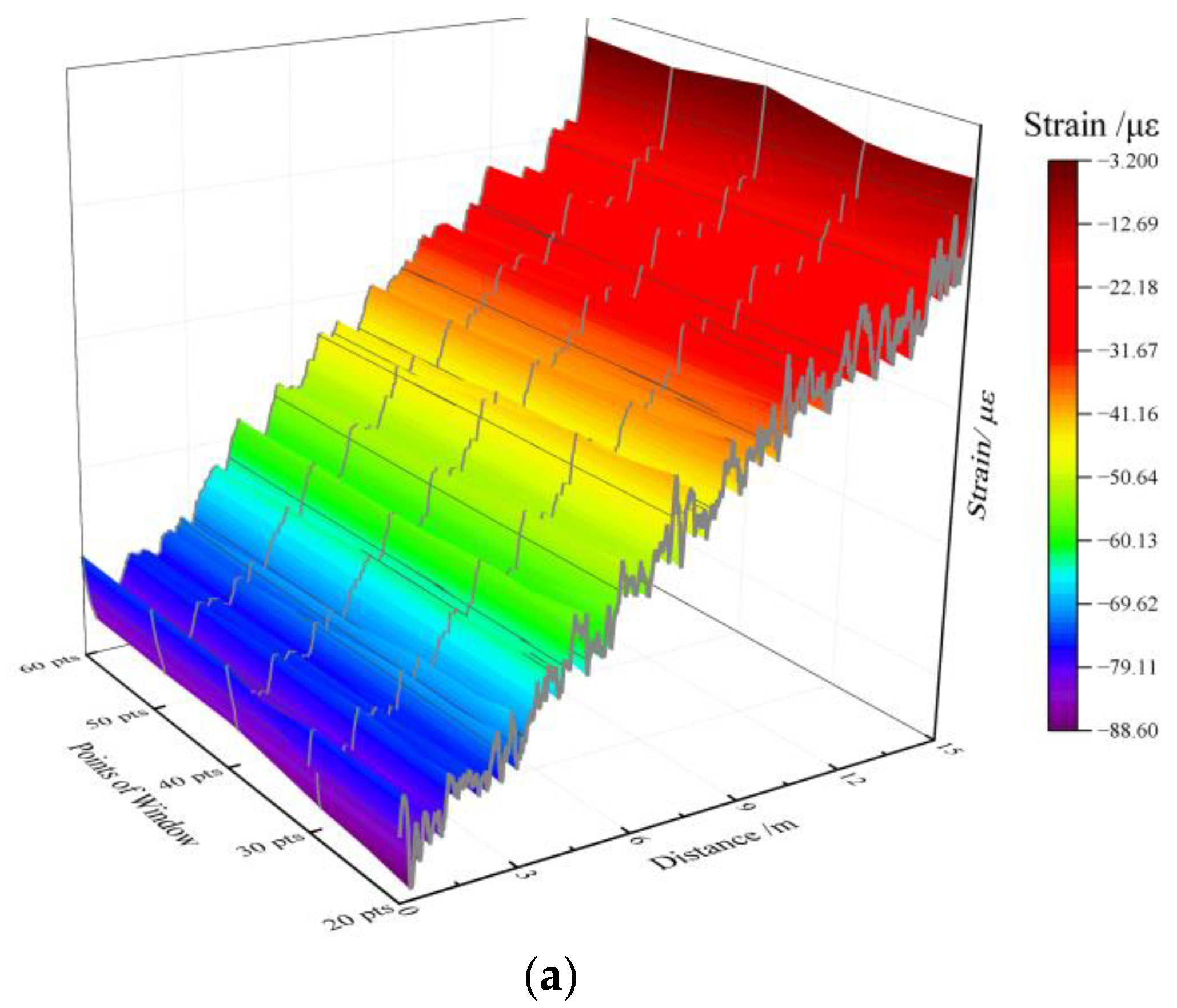
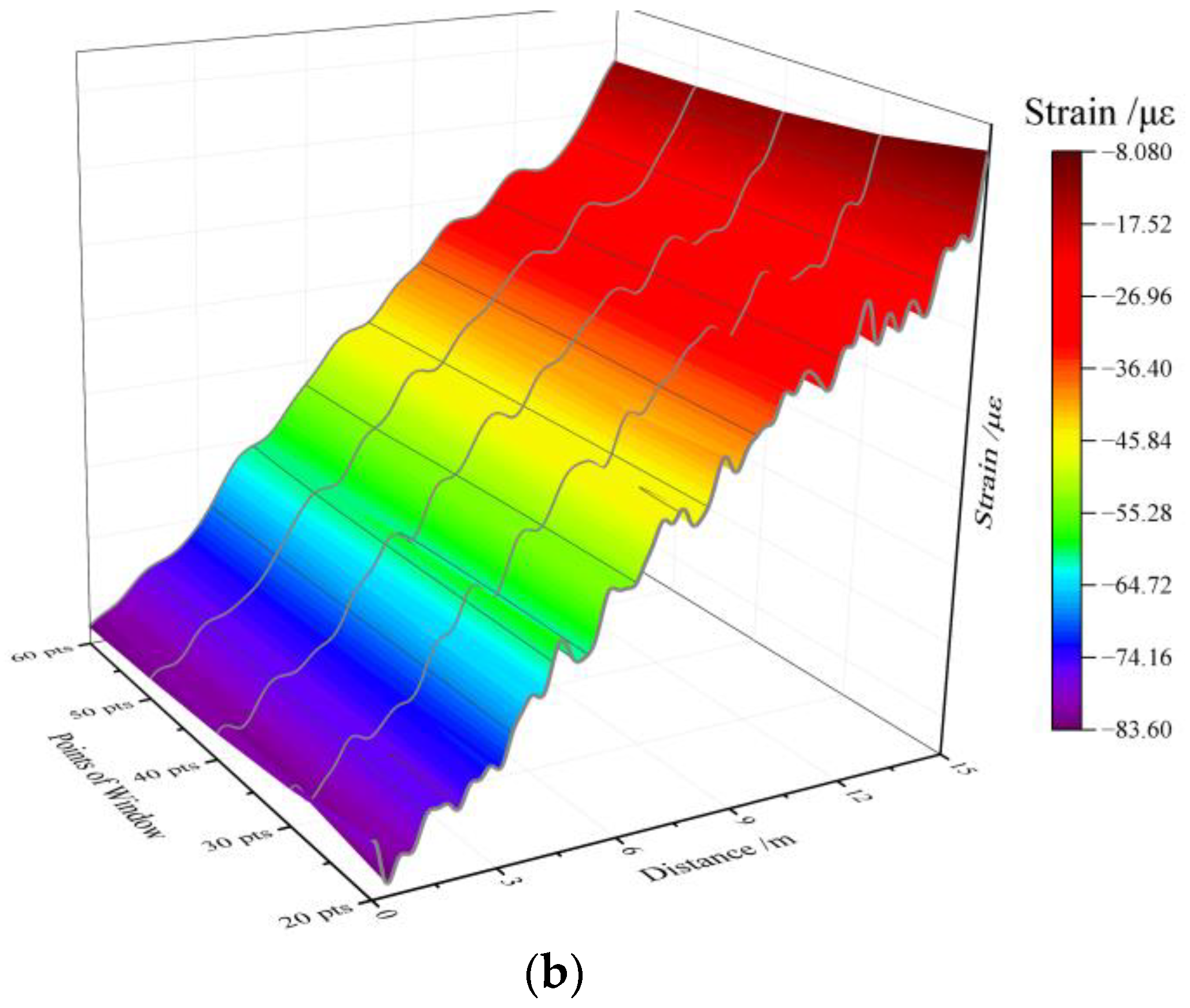


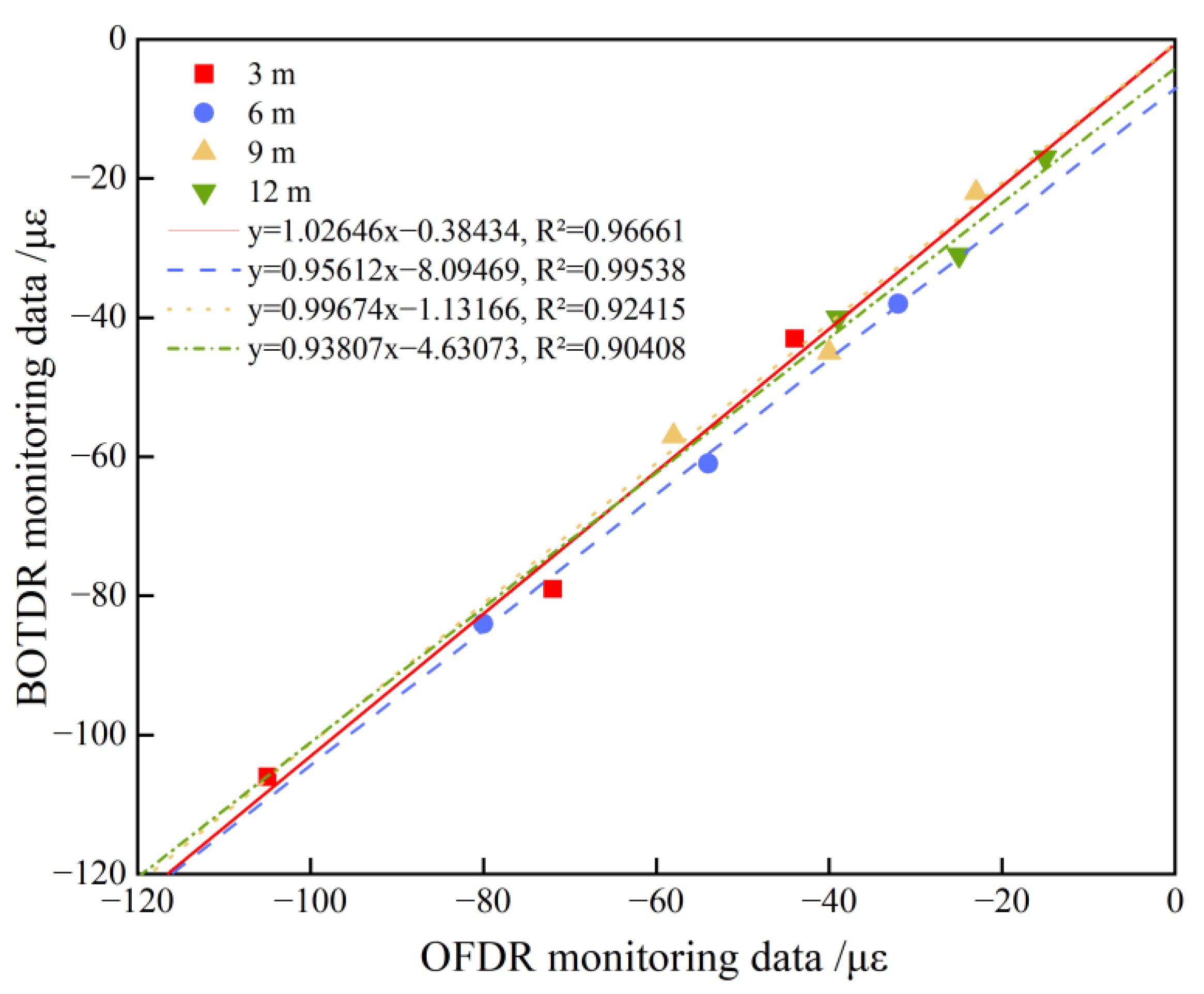
| Name | Test Item | Spatial Resolution | Maximum Spatial Resolution | Strain Sensing Precision | Sensing Range |
|---|---|---|---|---|---|
| OFDR | Temperature, strain | 1 mm | 1 mm | ±1 με | 100 m |
| BOTDR | Temperature, strain | 1 m | 5 cm | ±20 με | 0.5–80 km |
| Wavelet Function | OFDR | BOTDR | ||||
|---|---|---|---|---|---|---|
| RMSE | SNR | r | RMSE | SNR | r | |
| db2 | 7.5212 | 16.8995 | 0.1978 | 10.1323 | 15.3838 | 0.2872 |
| db3 | 7.6670 | 16.7327 | 0.1203 | 10.1774 | 15.3452 | 0.2322 |
| db4 | 7.4985 | 16.9257 | 0.1663 | 9.5799 | 15.8708 | 0.2972 |
| db5 | 7.6571 | 16.7438 | 0.0434 | 10.2231 | 15.3063 | 0.0955 |
| db6 | 7.6837 | 16.7138 | 0.0758 | 10.6659 | 14.9380 | 0.1720 |
| db7 | 7.6410 | 16.7622 | 0.0722 | 10.5838 | 15.0051 | 0.1620 |
| db8 | 7.6242 | 16.7813 | 0.0763 | 9.9320 | 15.5572 | 0.1543 |
| db9 | 7.6496 | 16.7524 | 0.1591 | 10.0291 | 15.4727 | 0.3124 |
| db10 | 7.6744 | 16.7243 | 0.1546 | 10.7909 | 14.8368 | 0.1546 |
| Smooth Way | RMSE | SNR | r |
|---|---|---|---|
| Adjacent-average method (40 points) | 7.6175 | 16.7889 | 0.0291 |
| FFT filter method (40 points) | 7.6987 | 16.6968 | 0.0058 |
| Distance/m | Load/kN | OFDR Monitoring Results /με | BOTDR Monitoring Results /με | Absolute Value of Data Error/με |
|---|---|---|---|---|
| 3 | 800 | −44 | −43 | 1 |
| 1200 | −72 | −79 | 7 | |
| 1600 | −105 | −106 | 1 | |
| 6 | 800 | −32 | −38 | 6 |
| 1200 | −54 | −61 | 7 | |
| 1600 | −80 | −84 | 4 | |
| 9 | 800 | −23 | −22 | 1 |
| 1200 | −40 | −45 | 5 | |
| 1600 | −58 | −57 | 1 | |
| 12 | 800 | −15 | −17 | 2 |
| 1200 | −25 | −31 | 6 | |
| 1600 | −39 | −40 | 1 |
| Technology Name | Sensing Speed | Operational Stability | Environmental Adaptability | Data Volatility |
|---|---|---|---|---|
| OFDR | Fast | Poor stability, prone to a lot of noise in long-term operation | Poor environmental adaptability and high requirements for operating temperature | Small |
| BOTDR | Slow | Good stability, long-term continuous operation | Good environmental adaptability | Big |
Publisher’s Note: MDPI stays neutral with regard to jurisdictional claims in published maps and institutional affiliations. |
© 2022 by the authors. Licensee MDPI, Basel, Switzerland. This article is an open access article distributed under the terms and conditions of the Creative Commons Attribution (CC BY) license (https://creativecommons.org/licenses/by/4.0/).
Share and Cite
Gao, L.; Qian, J.; Han, C.; Qin, S.; Feng, K. Experimental Study of Deformation Measurement of Bored Pile Using OFDR and BOTDR Joint Optical Fiber Sensing Technology. Sustainability 2022, 14, 16557. https://doi.org/10.3390/su142416557
Gao L, Qian J, Han C, Qin S, Feng K. Experimental Study of Deformation Measurement of Bored Pile Using OFDR and BOTDR Joint Optical Fiber Sensing Technology. Sustainability. 2022; 14(24):16557. https://doi.org/10.3390/su142416557
Chicago/Turabian StyleGao, Lei, Jiben Qian, Chuan Han, Shiwei Qin, and Kunpeng Feng. 2022. "Experimental Study of Deformation Measurement of Bored Pile Using OFDR and BOTDR Joint Optical Fiber Sensing Technology" Sustainability 14, no. 24: 16557. https://doi.org/10.3390/su142416557
APA StyleGao, L., Qian, J., Han, C., Qin, S., & Feng, K. (2022). Experimental Study of Deformation Measurement of Bored Pile Using OFDR and BOTDR Joint Optical Fiber Sensing Technology. Sustainability, 14(24), 16557. https://doi.org/10.3390/su142416557








